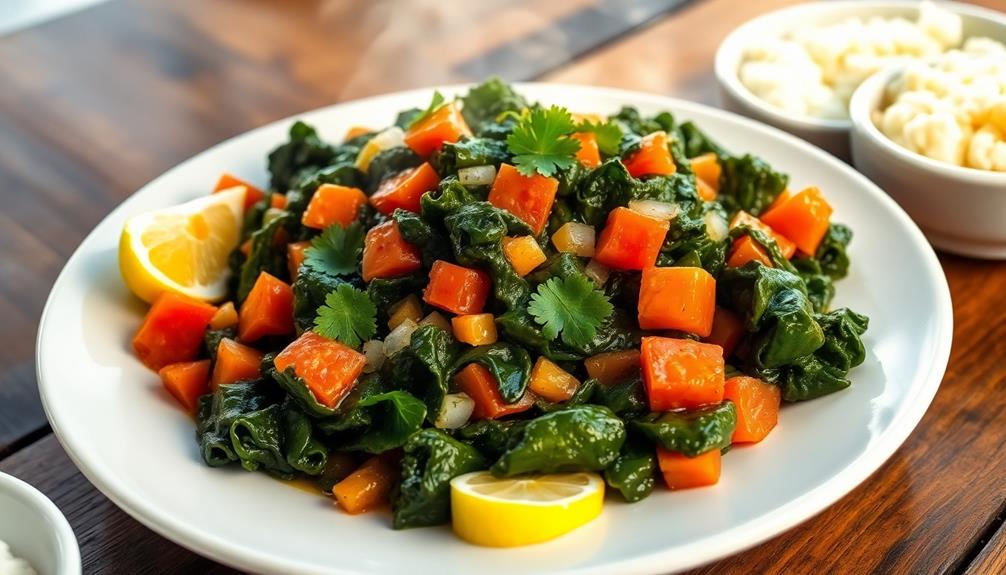Sukuma wiki is a beloved Kenyan dish that'll make your taste buds dance! This tasty meal, made from collard greens, onions, and tomatoes, is both nutritious and budget-friendly. You'll love how it stretches your food budget while filling your belly with goodness. It's super easy to cook, too! Just chop, sauté, and simmer for a quick and delicious meal. Serve it hot with ugali, a traditional Kenyan staple, for a true East African experience. Sukuma wiki's name means "stretch the week" in Swahili, and it's been helping families do just that for generations. Get ready to discover the magic of this Kenyan favorite! Looking to add some extra flavor to your Sukuma wiki? Why not try pairing it with a side of Nigerian suya recipe? This traditional Nigerian grilled meat dish, seasoned with spicy peanut sauce, will add an extra kick to your meal. The combination of Sukuma wiki and Nigerian suya recipe is sure to take your taste buds on a culinary journey through East Africa and beyond.
History
Throughout its history, sukuma wiki has been a staple food in East Africa, particularly in Kenya and Tanzania. You'll find this hearty, leafy green vegetable on dinner tables across the region, where it's been enjoyed for generations.
Sukuma wiki, which means "to stretch the week" in Swahili, got its name because it's an affordable way to make meals last longer.
In the early 20th century, as urbanization increased, sukuma wiki became even more popular. People moving to cities needed cheap, nutritious food that was easy to grow and prepare. That's where this amazing veggie stepped in! It's packed with vitamins and minerals, and it grows quickly in small spaces.
During times of economic hardship, sukuma wiki has been a lifesaver for many families. It's helped people stretch their food budgets and stay healthy.
Over the years, creative cooks have come up with countless ways to prepare it. You might find it stewed with tomatoes, mixed with beef, or seasoned with aromatic spices.
Today, sukuma wiki remains a beloved part of East African cuisine, continuing its long tradition of nourishing communities.
Recipe
Sukuma wiki, a popular East African dish, particularly in Kenya and Tanzania, is a nutritious and flavorful side dish made primarily with collard greens. The name "sukuma wiki" translates to "stretch the week" in Swahili, reflecting its affordability and ability to help families extend their food supplies throughout the week.
This simple yet satisfying dish combines tender collard greens with onions, tomatoes, and aromatic spices. It's often served alongside ugali (a thick maize porridge) or with rice, making it a versatile accompaniment to many meals. Sukuma wiki isn't only economical but also packed with vitamins and minerals, making it a healthy addition to any diet.
- 1 large bunch of collard greens, chopped
- 1 onion, diced
- 2 tomatoes, diced
- 2 tablespoons vegetable oil
- 2 cloves of garlic, minced
- 1 teaspoon curry powder
- Salt and pepper to taste
- Water
Heat oil in a large pan over medium heat. Add onions and garlic, sautéing until softened. Stir in curry powder, then add tomatoes and cook until they begin to break down.
Add chopped collard greens and a small amount of water. Cover and simmer for about 10-15 minutes, stirring occasionally, until the greens are tender but still vibrant. Season with salt and pepper to taste.
For the best results, choose fresh, crisp collard greens and avoid overcooking to maintain their nutrients and texture. You can adjust the spiciness by adding chili peppers or hot sauce to suit your taste.
Sukuma wiki can be made ahead of time and reheated, often tasting even better the next day as the flavors continue to meld.
Cooking Steps
To make sukuma wiki, you'll start by chopping onions and garlic, then sautéing kale until it's wilted.
Next, you'll add tomatoes and spices, letting everything simmer until the flavors blend together beautifully.
Once it's ready, serve your sukuma wiki piping hot alongside a generous portion of ugali for a truly satisfying meal.
Step 1. Chop Onions and Garlic
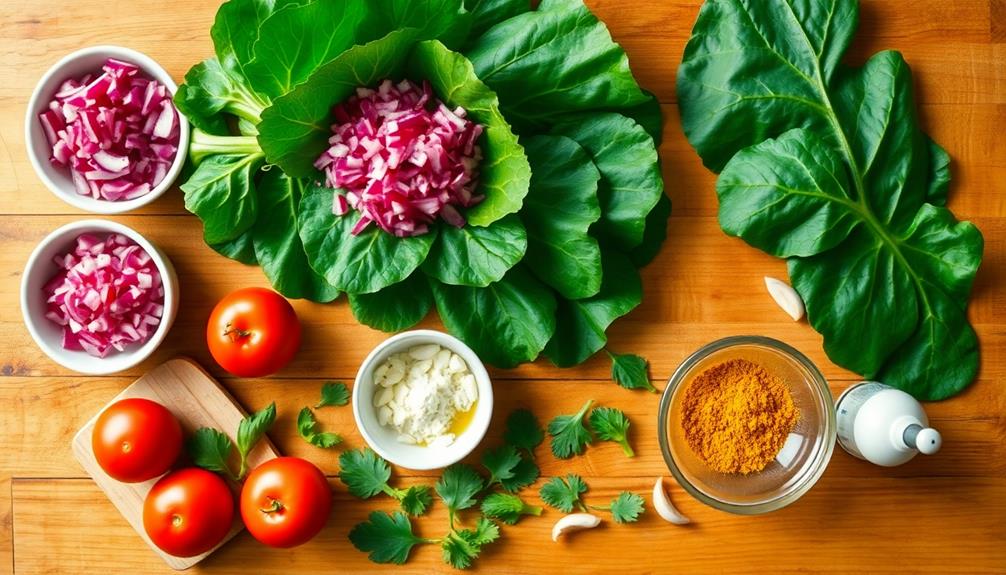
Preparation is key when cooking Sukuma Wiki. Let's start with the onions and garlic, two essential ingredients that'll give your dish a delicious flavor boost.
First, grab a sharp knife and a cutting board. You'll want to peel the outer skin off your onions and garlic cloves. For the onions, cut them in half from top to bottom, then slice them thinly. You'll end up with nice, crescent-shaped pieces that'll cook evenly in your pan.
Now, it's time for the garlic. Crush each clove with the flat side of your knife, and the skin will come off easily. Then, chop the garlic into small pieces.
Don't worry if they're not perfectly uniform – the important thing is to get them small enough to distribute their flavor throughout the dish. As you chop, you'll notice the strong, aromatic smell filling your kitchen. That's the sign of fresh, flavorful ingredients!
Step 2. Sauté Kale Until Wilted
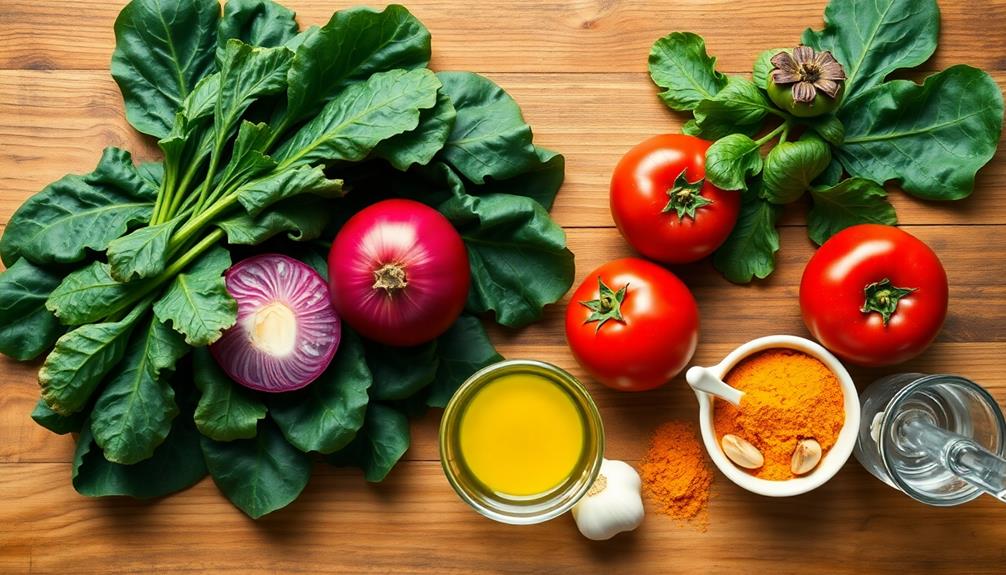
With your onions and garlic ready, it's time to focus on the star of the dish: kale. Grab a bunch of fresh, green kale and give it a good rinse under cool water. Shake off the excess water and pat it dry with a clean towel.
Now, take your sharp knife and remove the tough central stems from the kale leaves. You'll want to chop the leaves into bite-sized pieces, about 1-2 inches wide.
Heat up some oil in your pan over medium heat. Once it's hot, add your chopped kale to the pan. You'll hear a satisfying sizzle as the leaves hit the hot oil.
Use a wooden spoon or tongs to stir the kale, making sure all the leaves get coated with oil. As you cook, you'll notice the kale starting to change color, becoming a deeper, richer green.
Keep stirring and cooking until the kale wilts and becomes tender. This usually takes about 5-7 minutes. The leaves will shrink down quite a bit, so don't worry if it looks like too much at first!
Step 3. Add Tomatoes and Spices

Now that your kale is wilted and tender, it's time to add some vibrant flavor to your Sukuma Wiki. Grab a couple of ripe tomatoes and chop them into small, juicy chunks. Toss them into the pan with your kale, and watch as they start to sizzle and release their tangy goodness. The tomatoes will bring a pop of color and a burst of freshness to your dish.
Next, it's spice time! Sprinkle in some salt to enhance all the flavors, and add a pinch of black pepper for a gentle kick. If you like things a bit zesty, toss in some minced garlic or a dash of curry powder. These spices will make your Sukuma Wiki sing with delicious aromas that'll have everyone's mouths watering.
Stir everything together, making sure the tomatoes and spices are evenly distributed throughout the kale. Let it all simmer for a few minutes, allowing the flavors to mingle and dance together. Your kitchen will soon be filled with the most amazing smells, and you'll be counting down the minutes until you can dig in!
Step 4. Simmer Until Flavors Meld
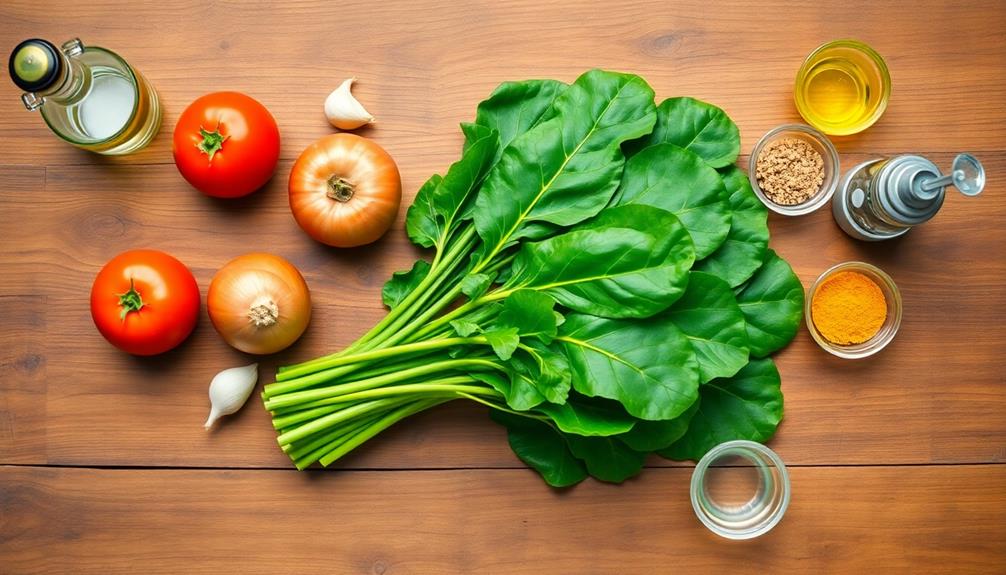
The final essential step in preparing Sukuma Wiki is to let it simmer gently. Once you've added the tomatoes and spices, it's time to turn down the heat and let the magic happen.
Cover your pot with a lid and allow the flavors to meld together for about 10 to 15 minutes. During this time, the kale will become tender and soak up all the delicious tastes you've created.
As the dish simmers, you'll notice the wonderful aroma filling your kitchen. It's a perfect moment to set the table or prepare any side dishes you'd like to serve with your Sukuma Wiki.
Stir the pot occasionally to make sure nothing sticks to the bottom. You'll know it's ready when the kale is soft and the sauce has thickened slightly. The tomatoes will have broken down, creating a rich, flavorful base for the greens.
Take a small taste to check if it needs any final seasoning adjustments. Once you're happy with the flavor and texture, it's time to serve your delicious Sukuma Wiki and enjoy this classic Kenyan dish!
Step 5. Serve Hot With Ugali
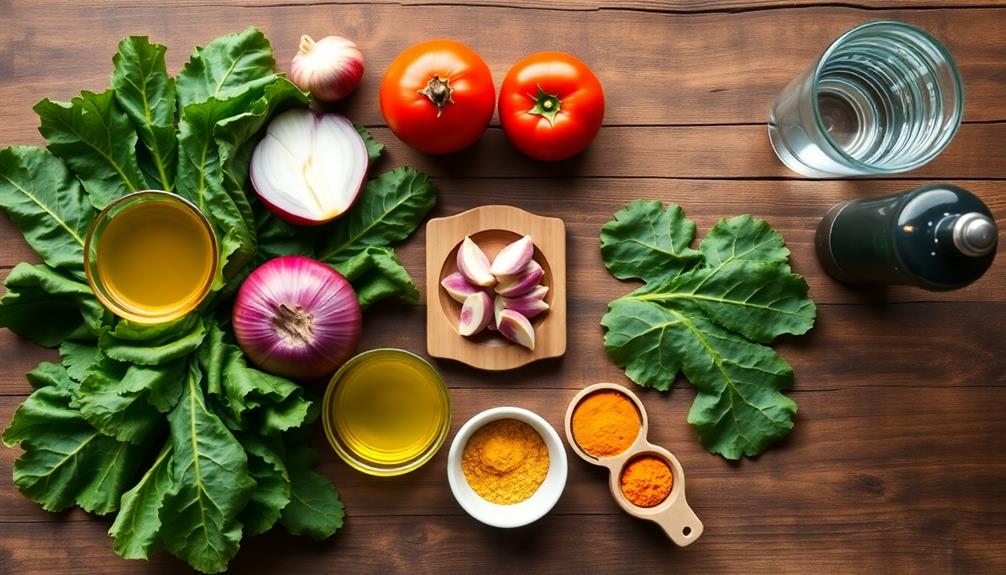
After your Sukuma Wiki has simmered to perfection, it's time to serve it alongside a classic Kenyan staple: ugali. This hearty cornmeal dish is the perfect complement to your flavorful greens.
To prepare ugali, you'll need to mix cornmeal with boiling water, stirring constantly until it forms a thick, dough-like consistency.
Once your ugali is ready, scoop a generous portion onto each plate. Next to it, ladle your steaming hot Sukuma Wiki, letting its savory aroma fill the air. The vibrant green color of the kale will look beautiful against the creamy white of the ugali.
Don't forget to add a sprinkle of fresh cilantro on top for an extra burst of flavor and color!
As you serve, encourage everyone to dig in with their hands, as is traditional in Kenya. Show them how to pinch off a small piece of ugali, shape it into a little scoop, and use it to pick up the Sukuma Wiki.
This hands-on eating experience adds a fun and authentic touch to your meal. Enjoy the wonderful combination of textures and flavors as you savor each bite!
Final Thoughts
Wrapping up our exploration of Sukuma Wiki, it's clear that this humble dish holds a special place in East African cuisine.
You've learned how to prepare this nutritious and tasty meal, from selecting the freshest kale to sautéing it with aromatic spices. The simplicity of Sukuma Wiki is part of its charm, making it accessible to cooks of all skill levels.
As you've discovered, this dish isn't just about filling your belly; it's a reflection of Kenyan culture and resourcefulness. You can now appreciate how Sukuma Wiki got its name, meaning "stretch the week," as it helps families make their food budgets last longer.
The versatility of this dish allows you to experiment with different ingredients and make it your own.
Whether you're serving it with ugali or trying it alongside other staples, Sukuma Wiki is sure to become a favorite in your kitchen.
Frequently Asked Questions
Is Sukuma Wiki Nutritious?
Yes, sukuma wiki is highly nutritious. You'll benefit from its rich content of vitamins A, C, and K, as well as iron and calcium. It's low in calories but high in fiber, making it a healthy addition to your diet.
Can Sukuma Wiki Be Frozen for Later Use?
You can freeze sukuma wiki for later use. It's best to blanch it first by briefly boiling, then cooling in ice water. Drain well, pack in airtight containers or freezer bags, and it'll keep for several months.
Are There Variations of Sukuma Wiki in Other African Countries?
You'll find variations of this dish across Africa. In Tanzania, it's called "Kisamvu." Uganda has "Nakati," while Nigeria offers "Efo." Each country adds its own twist, using local greens and spices to create unique flavors.
What Dishes Pair Well With Sukuma Wiki?
You'll find that rice, ugali, or chapati pair excellently with this dish. Try serving it alongside grilled meats or fish for a complete meal. Don't forget to add some avocado or a tangy salsa for extra flavor.
How Long Does Sukuma Wiki Last in the Refrigerator?
You'll find that properly stored sukuma wiki can last 3-5 days in your fridge. Make sure you cool it completely before refrigerating. For best quality, consume it within 2-3 days. You can reheat it as needed.
